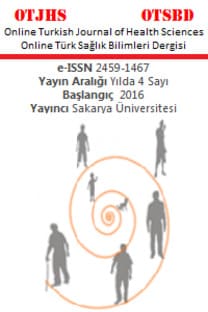İntravenöz Katater Uygulamasında Kullanılan Kelebek Desenli Tespit Malzemesinin Çocukların Emosyonel ve Fizyolojik Göstergelerine Etkisi
Çocuk, , dikkat dağıtma, , emosyonel durum, , intravenöz katater
The Effect of Butterfly Patterned Securement Dressing Used in Intravenous Catheter Administration on Children's Emotional and Physiological Indicators
Child, , distraction, , emotional state, , intravenous catheterization,
___
- Arıkan D, Çelebioğlu A, Güdücü Tüfekci F. Çocukluk dönemlerinde büyüme ve gelişme. İçinde: Conk Z, Başbakkal Z, Bal Yılmaz H, Bolışık B, eds. Pediatri Hemşireliği. 2. Baskı. Ankara: Akademisyen Kitabevi, 2018:53-66.
- Kyle, T. Essentials of Pediatric Nursing. 2nd ed. Philadelphia: LWW Publishing; 2008.
- Çavuşoğlu H. Hastaneye yatmanın çocuk ve aile üzerindeki etkileri. İçinde: Çavuşoğlu H, ed. Çocuk Sağlığı Hemşireliği. 10. baskı. Baskı Ankara: Sistem Ofset Basımevi, 2013:51-66.
- Li WH, Chung JOK, Ho KY, Kwok BMC. Play interventions to reduce anxiety and negative emotions in hospitalized children. BMC Pediatrics. 2016;16(1):1-9. doi:10.1186/s12887-016-0570-5
- Atak Meriç T. Okul öncesi dönemdeki çocuklarda venöz kan alımı sırasında iki farklı oyuncakla yapılan dikkati başka yöne çekme işleminin çocuğun emosyonel ve fizyolojik göstergelerine etkisi. Yeditepe Üniversitesi Sağlık Bilimleri Enstitüsü Hemşirelik Anabilim Dalı, Yüksek Lisans Tezi. İstanbul, Türkiye. 2017.
- Adams J, Motzhan A. Fluid-electrolyte acid–base balances. In: Potter PA, Perry AG, Ross-Kerr AJ, Wood MJ eds. Canadian Fundementals of Nursing. Elsevier, Inc; 2016:1144-1208.
- Rodriguez-Calero MA, Fernandez-Fernandez I, Molero-Ballester LJ, Matamalas-Massanet C. Risk factors for difficult peripheral venous cannulation in hospitalised patients. Protocol for a multicentre case–control study in 48 units of eight public hospitals in Spain. BMJ Open. 2018;8(2):1-6.
- Rivera AM, Strauss KW, Van Zundert AAJ, Mortier EP. Matching the peripheral intravenous catheter to the individual patient. Acta Anaesth Belg. 2007;58(1):19-25.
- Yen K, Riegert A, Gorelick MH. Derivation of the ZIVG score: a clinical prediction rule for the identification of children with difficult intravenous access. Pediatric Emergency Care. 2008;24(3):143-7. doi:10.1097/PEC.0b013e3181666f32
- Murayama R, Takahashi T, Tanabe H, et al. The relationship between the tip position of an indwelling venous catheter and the subcutaneous edema. Bioscience Trends. 2015;9(6):414-419.
- Cihan Erdoğan B, Denat Y. Periferik intravenöz kateter komplikasyonlarından infiltrasyon ve hemşirelik bakımı. Hemşirelikte Eğitim ve Araştırma Dergisi. 2016;13(2):157-162.
- James J, Ghai S, Rao K, Sharma N. Effectiveness of animated cartoons as a distraction strategy on behavioural response to pain perception amond children undergoing venipuncture. Nursing and Midwifery Research Journal. 2012;8(3):198-207.
- Vagnoli L, Caprilli S, Vernucci C, Zagni S, Mugnai F, Messeri A. Can presence of a dog reduce pain and distress in children during venipuncture? Pain Manag Nurs. 2015;16(2):89-95. doi:10.1016/j.pmn.2014.04.004
- William Li HC, Lopez V. Children's emotional manifestation scale: development and testing. Journal Clinical Journal. 2005;14(2):223-9. doi.org/10.1111/j.1365-2702.2004.01031.x
- He HG, Zhu L, Chan SWC, et al. Therapeutic play intervention on children's perioperative anxiety, negative emotional manifestation and postoperative pain: a randomized controlled trial. Journal of Advanced Nursing. 2015;71(5):1032-1043. doi:10.1111/jan.12608
- McMurtry CM. Pediatri needle procedure: parent-child interactions, child fear, and evidence-based treatment. Canadian Psychology/ Psychologie Canadienne. 2013;54(1):75-79.
- Özveren H. Ağrı kontrolünde farmakolojik olmayan yöntemler. Hacettepe Üniversitesi Hemşirelik Fakültesi Dergisi. 2011;18(1):83-92.
- Bagnasco A, Pezzi E, Rosa F, Fornonil L, Sasso L. Distraction techniques in children during venipuncture: an Italian experience. Journal of Preventive Medicine and Hygiene. 2012;53(1):44–48.
- Curtis S, Wingert A, Ali S. The Cochrane Library and procedural pain in children: An overview of reviews. Evidence‐Based Child Health: A Cochrane Review Journal. 2012;7(5):1363–1399. doi:10.1002/ebch.1864
- Karaca TN. Acil serviste çocuklarda damar yolu açma işlemine yönelik oluşan korku ve anksiyete üzerine müzikli-hareketli oyuncakların etkisi. Tokat Gaziosmanpaşa Üniversitesi Sağlık Bilimleri Enstitüsü Acil Tıp Hemşireliği Ana Bilim Dalı, Yüksek Lisans Tezi. Tokat, Türkiye. 2019.
- Erbay E. Çocuklarda periferik damar yolu açma girişimi sırasında yapılan dikkati dağıtma tekniğinin ağrıyı azaltmaya etkisi. Bülent Ecevit Üniversitesi Sağlık Bilimleri Enstitüsü Çocuk Sağlığı ve Hastalıkları Ana Bilim Dalı, Yüksek Lisans Tezi. Zonguldak, Türkiye. 2016.
- Nguyen TN, Nilsson S, Hellstrom AL, Bengtson A. Music therapy to reduce pain and anxiety in children with cancer undergoing lumbar puncture: A randomized clinical trial. J Pediatr Oncol Nurs. 2010;27(3):146-155. doi:10.1177/1043454209355983
- ISSN: 2459-1467
- Yayın Aralığı: 4
- Başlangıç: 2016
- Yayıncı: Oğuz KARABAY
Sibel ÜSTÜN ÖZEK, Canan EMIR, Rahsan İNAN
Dev Omfalosel: 23 Hasta; Üç Farklı Yaklaşım
Ortodontiye İlişkin Dünya Genelindeki İnternet Verilerinin Değerlendirilmesi: Google Trends Analizi
Muhammed Hilmi BÜYÜKÇAVUŞ, Burak KALE, Hikmet ORHAN
Bilateral Senkronize Over Torsionlu Bebek Hasta
Aytaç TAŞÇI, Hasan ARIK, Güleç MERT DOĞAN
Riskli Gebelerde Prenatal Bağlanma ve Risklerin Değerlendirilmesi
Ayça DEMİR YILDIRIM, Nevin ŞAHİN
Beyin Ölümü Tanısı Alan Hastaların Retrospektif Analizi
Youtube ve Astım: Astımla İlgili Popüler Videoların Bilgi İçeriğinin Eleştirel Bir Değerlendirmesi
Fatma Esra GÜNAYDIN, Sedat ALTIN
Mehtap BİNGÜL, Duygu SÖMEN BAYOĞLU, Tamay GÜRBÜZ, Pınar ALAGÖZ, Sebahat AKSARAY, Çağatay NUHOĞLU
